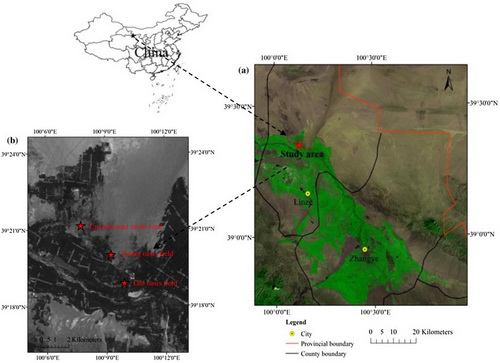Sustainable use of cultivated desert soils is important for agricultural productivity in desert-oasis ecosystems. However, how soil macropore characteristics may change as a result of agricultural exploitation remains unclear. The objective of this study was to quantify and compare soil properties and macropore characteristics in an old oasis field (>50 years of cultivation, OOF), young oasis field (20 years, YOF), and adjacent uncultivated sandy land (0 year, USL) in Northwest China. Three replicated soil samples were collected from each site to investigate soil properties. Meanwhile, twelve (four replicates by three sites) intact soil core columns, 15 cm in diameter and 30 cm in height, were taken to analyze soil structure. Each soil column was scanned with a helical medical X-ray computed tomography (CT) at a voxel resolution of 0.469 mm × 0.469 mm × 0.600 mm. The results indicated that soil properties and macropore features improved after cultivation. Silt and clay content and dry mean weight diameter (DMWD) of aggregates increased with cultivation time, whereas bulk density decreased. Soil organic carbon and total nitrogen were 7.3 times and 6.7 times greater in soils at the OOF site than USL site, respectively. The increase in silt and clay content and aggregates formation likely resulted from irrigation with silt-laden river water, which in turn impacted soil nutrient accumulation. Soils at the OOF and YOF sites had greater macroporosity compared with soil at USL, and macroporosity also increased with cultivation time. X-ray CT revealed that soil macroporosity was 8.7–18.9 times greater in irrigated croplands than native desert. Soil macropores were mainly distributed at soil depths of 0–200 mm at the OOF and YOF sites, while smaller and less continuous macropores were randomly distributed across soil depths at the USL site. The larger number of macropores at the cultivated sites can be attributed to greater soil organic carbon, tillage-induced soil horizons, and alternate wetting and drying processes. Few soil macropores at the USL site may be associated with wind erosion and soil fauna burrows. Conversion of native desert soils to irrigated croplands had a positive effect on soil pore development in the desert-oasis ecotone. This research achievement is published on Soil and Tillage Research. Keywords: Computed tomography; Cultivation; Desert-oasis region; Desert soils; Soil macropores 
Fig. Location of the study area (a) and soil sampling sites (b). |

